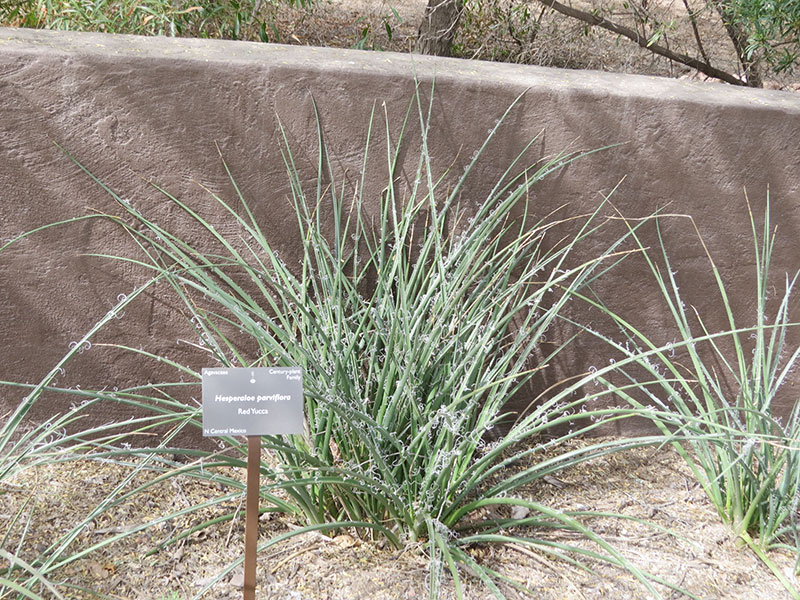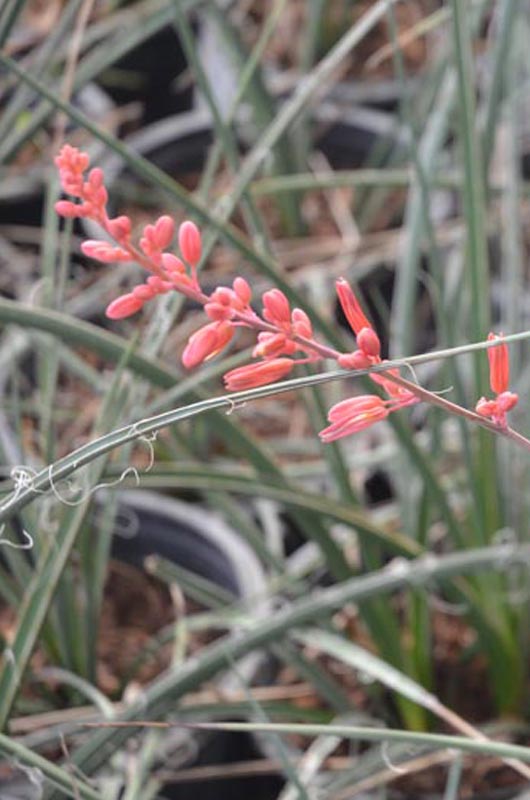
Woody > Hesperaloe > Hesperaloe parviflora > Hesperaloe parviflora
Hesperaloe parviflora
Red Yucca, Red Hesperaloe, Coral Yucca, Red Flowered False Yucca, Samandoque
Origin: Northern Mexico and the south-western United States of America (Texas) in the Rio Grande Valley.
Mike's
Opinion


"
Hesperaloe parviflora which blooms throughout the summer months is an easy care, drought tolerant plant. It has been found to tolerate the dry winters of USDA zone 7 and to USDA zone 6 in moister climates. It is similar to Yucca in character however the foliage is often narrower and the blooms red instead of creamy-white.
Michael Pascoe, NDP., ODH., CLT., MSc. (Plant Conservation)
"
| Family |
| Asparagaceae |
| Genus |
| Hesperaloe |
| Species |
| parviflora |
| Category |
| Woody |
| Type |
| Shrub (evergreen) |
| Pronunciation |
| USDA Hardiness Zone |
| 6 - 7 |
| Canadian Hardiness Zone |
| 8 |
| RHS Hardiness Zone |
| H5 |
| Temperature (°C) |
| -11 |
| Temperature (°F) |
| 12 |
| Height |
| 0.5 - 1.5 m |
| Spread |
| 1 m |
Photographs
Description and Growing Information
Flowering Period
| General Description |
| An attractive landscape plant featuring coral red flowers during the summer months and clumps of thick green foliage. |
| Landscape |
| Can be used as an accent plant, in xeriscaping or to attract hummingbirds. It is extremely drought tolerant and is used in many southwestern gardens. |
| Cultivation |
| Minimal maintenance is required such as removing the spent flower stems. It requires full sun and supplemental irrigation in arid environments for best flowering; however, overall it needs minimal water as it is very drought tolerant. It prefers a soil pH of 6.8-7.2. |
| Shape |
| Grows in clumps or mounds of succulent grass-like, stemless plants. |
| Growth |
| Medium |
| ID Characteristic |
| Hesperaloe parviflora can be identified by its foliage which is similar to that of Yucca except that the leaf apices lack a spine Its coral red flowers that resemble lilies are quite distinct |
| Pests |
| Aphids can be problematic during bloom. |
| Habitat |
| Growth restricted to Mexico and the lower Rio Grande Valley and Texas. Found on prairies; rocky slopes; mesquite groves on well drained sand, loam, caliche, or limestone. |
| Bark/Stem Description |
| The plant is stemless. |
| Leaf Description |
| The simple, glaborous leaves have parallel venation, ciliate margins, acuminate apex and a truncate base. Foliage can be described as thick green rounded threadlike clumps or blades of about 60 – 90 cm. Leaves produce a curly white filament along its margins similar in character to Yucca, but lack the spike at apex found on Yucca's. |
| Flower Description |
| The bisexual, coral red, bell shaped flowers are produced in early-mid summer with the flower spike resembling tall wands: flowers are about 35 mm in size. To encourage flowering, full sun and supplemental irrigation is recommended. |
| Fruit Description |
| The black seeds about 3 cm in length can be found in multi-chambered capsules about the size of a ping pong ball held aloft on 1 m stems originating from the centre of the plant. |
| Colour Description |
| Foliage is dark green, while flowers are coral red. However in the winter the foliage takes on a plum coloured hue. |
| Texture Description |
| Foliage texture is similar to leather and fibrous along the edges. |
| Notable Specimens |
| Denver Botanic Gardens, Denver, Colorado, United States of America. |
| Propagation |
| Sow untreated seeds in flats by moistening the media and gently pressing the seeds into it. Keep the flats in a cold frame until the following spring. Once the seeds have sprouted wait 6 months before moving them to full sun light. |
References
Baldwin, Debra Lee. Designing with Succulents. Portland: Timber Press, 2007. 151.

